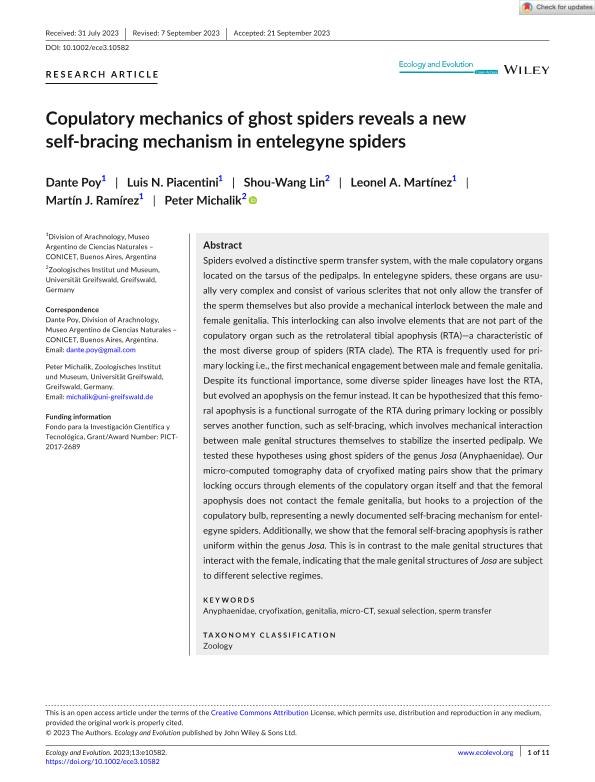Artículo
Copulatory mechanics of ghost spiders reveals a new self-bracing mechanism in entelegyne spiders
Poy, Dante ; Piacentini, Luis Norberto
; Piacentini, Luis Norberto ; Lin, Shou Wang; Martínez García, Leonel Antonio
; Lin, Shou Wang; Martínez García, Leonel Antonio ; Ramirez, Martin Javier
; Ramirez, Martin Javier ; Michalik, Peter
; Michalik, Peter
 ; Piacentini, Luis Norberto
; Piacentini, Luis Norberto ; Lin, Shou Wang; Martínez García, Leonel Antonio
; Lin, Shou Wang; Martínez García, Leonel Antonio ; Ramirez, Martin Javier
; Ramirez, Martin Javier ; Michalik, Peter
; Michalik, Peter
Fecha de publicación:
10/2023
Editorial:
John Wiley & Sons Ltd
Revista:
Ecology and Evolution
ISSN:
2045-7758
Idioma:
Inglés
Tipo de recurso:
Artículo publicado
Clasificación temática:
Resumen
Spiders evolved a distinctive sperm transfer system, with the male copulatory organs located on the tarsus of the pedipalps. In entelegyne spiders, these organs are usually very complex and consist of various sclerites that not only allow the transfer of the sperm themselves but also provide a mechanical interlock between the male and female genitalia. This interlocking can also involve elements that are not part of the copulatory organ such as the retrolateral tibial apophysis (RTA)—a characteristic of the most diverse group of spiders (RTA clade). The RTA is frequently used for primary locking i.e., the first mechanical engagement between male and female genitalia. Despite its functional importance, some diverse spider lineages have lost the RTA, but evolved an apophysis on the femur instead. It can be hypothesized that this femoral apophysis is a functional surrogate of the RTA during primary locking or possibly serves another function, such as self-bracing, which involves mechanical interaction between male genital structures themselves to stabilize the inserted pedipalp. We tested these hypotheses using ghost spiders of the genus Josa (Anyphaenidae). Our micro-computed tomography data of cryofixed mating pairs show that the primary locking occurs through elements of the copulatory organ itself and that the femoral apophysis does not contact the female genitalia, but hooks to a projection of the copulatory bulb, representing a newly documented self-bracing mechanism for entelegyne spiders. Additionally, we show that the femoral self-bracing apophysis is rather uniform within the genus Josa. This is in contrast to the male genital structures that interact with the female, indicating that the male genital structures of Josa are subject to different selective regimes.
Palabras clave:
ANYPHAENIDAE
,
CRYOFIXATION
,
GENITALIA
,
MICRO-CT
,
SEXUAL SELECTION
,
SPERM TRANSFER
Archivos asociados
Licencia
Identificadores
Colecciones
Articulos(MACNBR)
Articulos de MUSEO ARG.DE CS.NAT "BERNARDINO RIVADAVIA"
Articulos de MUSEO ARG.DE CS.NAT "BERNARDINO RIVADAVIA"
Citación
Poy, Dante; Piacentini, Luis Norberto; Lin, Shou Wang; Martínez García, Leonel Antonio; Ramirez, Martin Javier; et al.; Copulatory mechanics of ghost spiders reveals a new self-bracing mechanism in entelegyne spiders; John Wiley & Sons Ltd; Ecology and Evolution; 13; 10; 10-2023; 1-11
Compartir
Altmétricas



